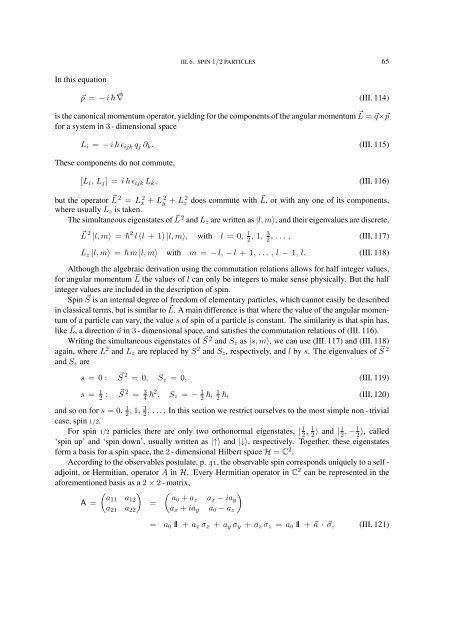FOUNDATIONS OF QUANTUM MECHANICS
FOUNDATIONS OF QUANTUM MECHANICS
FOUNDATIONS OF QUANTUM MECHANICS
Create successful ePaper yourself
Turn your PDF publications into a flip-book with our unique Google optimized e-Paper software.
III. 6. SPIN 1/2 PARTICLES 65<br />
In this equation<br />
⃗p = − i ⃗ ∇ (III. 114)<br />
is the canonical momentum operator, yielding for the components of the angular momentum ⃗ L = ⃗q×⃗p<br />
for a system in 3 - dimensional space<br />
L i = − i ϵ ijk q j ∂ k . (III. 115)<br />
These components do not commute,<br />
[L i , L j ] = i ϵ ijk L k , (III. 116)<br />
but the operator ⃗ L 2 = L 2 x + L 2 y + L 2 z does commute with ⃗ L, or with any one of its components,<br />
where usually L z is taken.<br />
The simultaneous eigenstates of ⃗ L 2 and L z are written as |l, m⟩, and their eigenvalues are discrete,<br />
⃗L 2 |l, m⟩ = 2 l (l + 1) |l, m⟩, with l = 0, 1 2 , 1, 3 2<br />
, . . . , (III. 117)<br />
L z |l, m⟩ = m |l, m⟩ with m = − l, − l + 1, . . . , l − 1, l. (III. 118)<br />
Although the algebraic derivation using the commutation relations allows for half integer values,<br />
for angular momentum ⃗ L the values of l can only be integers to make sense physically. But the half<br />
integer values are included in the description of spin.<br />
Spin ⃗ S is an internal degree of freedom of elementary particles, which cannot easily be described<br />
in classical terms, but is similar to ⃗ L. A main difference is that where the value of the angular momentum<br />
of a particle can vary, the value s of spin of a particle is constant. The similarity is that spin has,<br />
like ⃗ L, a direction ⃗n in 3 - dimensional space, and satisfies the commutation relations of (III. 116).<br />
Writing the simultaneous eigenstates of ⃗ S 2 and S z as |s, m⟩, we can use (III. 117) and (III. 118)<br />
again, where L 2 and L z are replaced by S 2 and S z , respectively, and l by s. The eigenvalues of ⃗ S 2<br />
and S z are<br />
s = 0 : ⃗ S 2 = 0, S z = 0, (III. 119)<br />
s = 1 2 : S ⃗ 2 = 3 4 2 , S z = − 1 2 , 1 2<br />
, (III. 120)<br />
and so on for s = 0, 1 2 , 1, 3 2<br />
, . . . . In this section we restrict ourselves to the most simple non - trivial<br />
case, spin 1/2.<br />
For spin 1/2 particles there are only two orthonormal eigenstates, | 1 2 , 1 2 ⟩ and | 1 2 , − 1 2<br />
⟩, called<br />
‘spin up’ and ‘spin down’, usually written as |↑⟩ and |↓⟩, respectively. Together, these eigenstates<br />
form a basis for a spin space, the 2 - dimensional Hilbert space H = C 2 .<br />
According to the observables postulate, p. 41, the observable spin corresponds uniquely to a self -<br />
adjoint, or Hermitian, operator A in H. Every Hermitian operator in C 2 can be represented in the<br />
aforementioned basis as a 2 × 2 - matrix,<br />
A =<br />
( )<br />
a11 a 12<br />
a 21 a 22<br />
=<br />
( )<br />
a0 + a z a x − ia y<br />
a x + ia y a 0 − a z<br />
= a 0 11 + a x σ x + a y σ y + a z σ z = a 0 11 + ⃗a · ⃗σ, (III. 121)
















